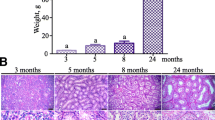Abstract
The spermatogenesis associated 4 gene (SPATA4, previously named TSARG2) was first cloned from a mouse testis cDNA library and was reported to be a candidate apoptosis-related gene in male germ cells. In this study, we cloned and characterized the SPATA4 gene from chicken (Gallus gallus). Bioinformatics analysis shows that the chicken SPATA4 gene is located on chromosome 4, is made up of six exons, and contains an 860 bp open reading frame encoding a putative protein of 250 amino acids. Further analysis of the SPATA4 gene sequence indicates that it is highly conserved between avian and mammalian species. Multi-tissue RT-PCR results indicate that the chicken SPATA4 gene is specifically expressed in the testis. Moreover, according to multi-time RT-PCR results, the expression of chicken SPATA4 occurs in a development stage-dependent pattern, and is gradually upregulated during the developmental process in chicken testis. All of these results suggest that SPATA4 may play an important role in the chicken spermatogenesis process.





Similar content being viewed by others
References
Eddy EM (2002) Male germ cell gene expression. Recent Prog Horm Res 57:103–128
Vanderhyden B (2002) Molecular basis of ovarian development and function. Front Biosci 7:2006–2022
Nakanishi Y (1995) Study on the mammalian spermatogenic pathway. Yakugaku Zasshi 115:420–430
Krajewski S, Bodrug S, Krajewska M, Shabaik A, Gascoyne R, Berean K, Reed JC (1995) Immunohistochemical analysis of Mcl-1 protein in human tissues. Differential regulation of Mcl-1 and Bcl-2 protein production suggests a unique role for Mcl-1 in control of programmed cell death in vivo. Am J Pathol 146:1309–1319
Riou G, Barrois M, Prost S, Terrier MJ, Theodore C, Levine AJ (1995) The p53 and mdm-2 genes in human testicular germ-cell tumors. Mol Carcinog 12:124–131
Blendy JA, Kaestner KH, Weinbauer GF, Nieschlag E, Schutz G (1996) Severe impairment of spermatogenesis in mice lacking the CREM gene. Nature 380:162–165
Dix DJ, Allen JW, Collins BW, Mori C, Nakamura N, Poorman-Allen P, Goulding EH, Eddy EM (1996) Targeted gene disruption of Hsp70-2 results in failed meiosis, germ cell apoptosis, and male infertility. Proc Natl Acad Sci U S A 93:3264–3268
Sarge KD, Cullen KE (1997) Regulation of hsp expression during rodent spermatogenesis. Cell Mol Life Sci 53:191–197
Nagata S, Golstein P (1995) The Fas death factor. Science 267:1449–1456
Bretz JD, Rymaszewski M, Arscott PL, Myc A, Ain KB, Thompson NW, Baker JR (1999) TRAIL death pathway expression and induction in thyroid follicular cells. J Biol Chem 274:23627–23632
Kodaira K, Takahashi R, Hirabayashi M, Suzuki T, Obinata M, Ueda M (1996) Overexpression of c-myc induces apoptosis at the prophase of meiosis of rat primary spermatocytes. Mol Reprod Dev 45:403–410
Guo CX, Hu ZY, Zhou YJ, Mu XM, Liu YX (1999) The expression of orphan receptor TR2 mRNA in spermatocyte of rat and Macaca mulatta cryptorchidism. Chin Sci Bull 44:2539–2544
Jiang H, Li LY, Lu GX (2001) Molecular cloning of genes related to apoptosis in spermatogenic cells of mouse. Acta Biochim Biophys Sin 33:421–425
Liu SF, Li LY, Fu JJ, Xing XW, Liu G, Lu GX (2002) Molecular cloning of SRG2, a mouse testis spermatocyte apoptosis-related gene. Acta Biochim Biophys Sin 34:796–799
Liu SF, Li LY, Fu JJ, Liu G, Xing XW, Lu GX (2002) Rapid identification of human testis spermatocyte apoptosis-related gene, TSARG2, by nested PCR and draft human genome searching. Acta Biochim Biophys Sin 34:378–382
Liu SF, He S, Liu BW, Zhao Y, Wang Z (2004) Cloning and characterization of testis-specific spermatogenesis associated gene homologous to human SPATA4 in rat. Biol Pharm Bull 27:1867–1870
Liu BW, Liu SF, He S, Zhao Y, Hu H, Wang Z (2005) Cloning and expression analysis of gonadogenesis-associated gene SPATA4 from rainbow trout (Oncorhynchus mykiss). J Biochem Mol Biol 38:206–210
Liu SF, Liu BW, He S, Zhao Y, Wang Z (2005) Cloning and characterization of zebrafish SPATA4 gene and analysis of its gonad specific expression. Biochemistry (Mosc) 70:773–781
Liu SF, Ai C, Ge ZQ, Liu HL, Liu BW, He S, Wang Z (2005) Molecular cloning and bioinformatic analysis of SPATA4 gene. J Biochem Mol Biol 6:739–747
Lynch M, Conery JS (2000) The evolutionary fate and consequences of duplicate genes. Science 290:1151–1155
Jones RC, Lin M (1993) Spermatogenesis in birds. Oxf Rev Reprod Biol 15:233–264
Beaupre CE, Tressler CJ, Beaupre SJ, Morgan JL, Bottje WG, Kirby JD (1997) Determination of testis temperature rhythms and effects of constant light on testicular function in the domestic fowl (Gallus domesticus). Biol Reprod 56:1570–1575
Bendtsen JD, Nielsen H, Von Heijne G, Brunak S (2004) Improved prediction of signal peptides: SignalP 3.0. J Mol Biol 340:783–795
Xie D, Li A, Wang MH, Fan ZW, Feng HQ (2005) LOCSVMPSI: a web server for subcellular localization of eukaryotic proteins using SVM and profile of PSI-BLAST. Nucleic Acids Res 33:105–110
Yip YL, Scheib H, Diemand AV, Gattiker A, Famiglietti LM, Gasteiger E, Bairoch A (2004) The Swiss-Prot variant page and the ModSNP database: a resource for sequence and structure information on human protein variants. Hum Mutat 23:464–470
Liu SF, Li LY, Mo YQ, Fu JJ, Liu G, Xing XW, Lu GX (2003) Molecular cloning and expression in cryptorchid testis of SRG2 from a mouse testis spermatocyte apoptosis-related gene. Acta Genet Sin 30:943–948
Liu SF, Lu GX, Liu G, Xing XW, Li LY, Wang Z (2004) Cloning of a full-length cDNA of human testis-specific spermatogenic cell apoptosis inhibitor TSARG2 as a candidate oncogene. Biochem Biophys Res Commun 319:32–40
Acknowledgements
This work was supported by research grants of “National Basic Research Program of China” (No. 2007CB507406) and “China Postdoctoral Science Foundation” (No. 20060390477).
Author information
Authors and Affiliations
Corresponding author
Rights and permissions
About this article
Cite this article
Xie, MC., Ai, C., Jin, XM. et al. Cloning and characterization of chicken SPATA4 gene and analysis of its specific expression. Mol Cell Biochem 306, 79–85 (2007). https://doi.org/10.1007/s11010-007-9556-9
Received:
Accepted:
Published:
Issue Date:
DOI: https://doi.org/10.1007/s11010-007-9556-9




